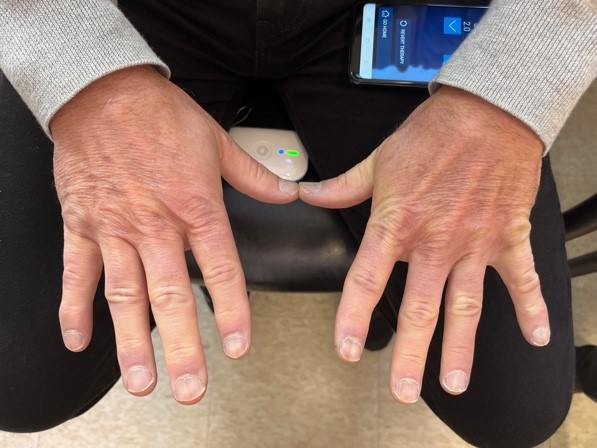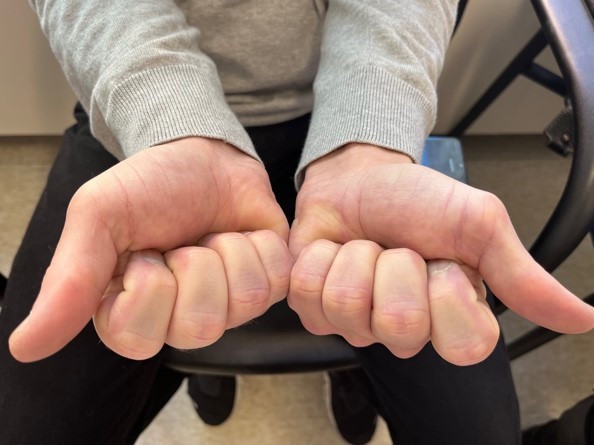Objective: Deep brain stimulation (DBS) of the subthalamic nucleus (STN) is an effective treatment for motor symptoms in advanced Parkinson’s disease (PD). However, autonomic side effects may occur during programming. We report a unique case of Raynaud’s phenomenon, characterized by vasospasms of the fingers, and diaphoresis during initial STN DBS programming.
Background: STN DBS is known to impact motor function in PD, but its effects on the autonomic nervous system are less well understood. Autonomic side effects such as changes in blood pressure, gastrointestinal function, bladder control, and hyperhidrosis have been reported. However, Raynaud’s phenomenon, a condition involving episodic vasospasms of the fingers and toes, has not been previously described in the context of DBS programming.
Method: Case report
Results: A 50-year-old male with young-onset Parkinson Disease with genetic testing positive for GBA 1,TAF1 , ATP7B , PLA2G6 and apathy who underwent bilateral STN DBS. During initial programming with high amplitude in contacs 2 and 10, he developed Raynaud’s phenomenon, presenting as vasospasms, color and temperature changes in both hands. Figure 1a. and 1b. Additionally, he experienced right-sided diaphoresis and a sensation of heat. These symptoms resolved with stimulation cessation, and final DBS parameters were adjusted accordingly.
Conclusion: The occurrence of Raynaud’s phenomenon and diaphoresis during STN DBS programming suggests an acute impact on sympathetic tone and autonomic function. This may be due to stimulation of central autonomic fibers originating from the lateral hypothalamus, which lie in close proximity to the STN. In this patient the ventromedial location of the DBS electrodes, targeting both motor and limbic regions, may have contributed to these autonomic effects. This case highlights the potential for autonomic side effects, particularly Raynaud’s phenomenon and diaphoresis, during STN DBS programming in PD. Further research is needed to elucidate the neural mechanisms underlying autonomic responses to neuromodulation and to optimize programming strategies.
Raynaud’s phenomenon 1a.
Raynaud’s phenomenon 1b.
References: 1. Masood N, Jimenez-Shahed J. Effective Management of “OFF” Episodes in Parkinson’s Disease: Emerging Treatment Strategies and Unmet Clinical Needs. Neuropsychiatr Dis Treat. 2023;19:247-66.
2. Hariz M, Blomstedt P. Deep brain stimulation for Parkinson’s disease. J Intern Med. 2022;292(5):764-78.
3. Hartmann CJ, Fliegen S, Groiss SJ, Wojtecki L, Schnitzler A. An update on best practice of deep brain stimulation in Parkinson’s disease. Ther Adv Neurol Disord. 2019;12:1756286419838096.
4. Patel B, Chiu S, Wong JK, Patterson A, Deeb W, Burns M, et al. Deep brain stimulation programming strategies: segmented leads, independent current sources, and future technology. Expert Rev Med Devices. 2021;18(9):875-91.
5. Bellini G, Best LA, Brechany U, Mills R, Pavese N. Clinical Impact of Deep Brain Stimulation on the Autonomic System in Patients with Parkinson’s Disease. Mov Disord Clin Pract. 2020 Apr 7;7(4):373-382. doi: 10.1002/mdc3.12938. PMID: 32373653; PMCID: PMC7197307.
6. Herrick AL, Wigley FM. Raynaud’s phenomenon. Best Pract Res Clin Rheumatol. 2020;34(1):101474.
7. Zhang F, Wang F, Li CH, Wang JW, Han CL, Fan SY, et al. Subthalamic nucleus-deep brain stimulation improves autonomic dysfunctions in Parkinson’s disease. BMC Neurol. 2022;22(1):124.
8. van der Plas J, Wiersinga-Post JE, Maes FW, Bohus B. Cardiovascular effects and changes in midbrain periaqueductal gray neuronal activity induced by electrical stimulation of the hypothalamus in the rat. Brain Res Bull. 1995;37(6):645-56.
9. Spencer SE, Sawyer WB, Loewy AD. L-glutamate stimulation of the zona incerta in the rat decreases heart rate and blood pressure. Brain Res. 1988;458(1):72-81.
10. Kaufmann H, Bhattacharya KF, Voustianiouk A, Gracies JM. Stimulation of the subthalamic nucleus increases heart rate in patients with Parkinson disease. Neurology. 2002;59(10):1657-8.
11. Thornton JM, Aziz T, Schlugman D, Paterson DJ. Electrical stimulation of the midbrain increases heart rate and arterial blood pressure in awake humans. J Physiol. 2002;539(Pt 2):615-21.
12. Lam S, Langevin JP, Malkasian D, Gorgulho A, DeSalles A. Deep brain stimulator-induced diaphoresis in Parkinson’s disease patients. J Clin Neurosci. 2014;21(4):676-8.
13. Haque A, Hughes M. Raynaud’s phenomenon. Clin Med (Lond). 2020;20(6):580-7.
14. Arbouw ME, Movig KL, Guchelaar HJ, Neef C, Egberts TC. Dopamine agonists and ischemic complications in Parkinson’s disease: a nested case-control study. Eur J Clin Pharmacol. 2012;68(1):83-8.
To cite this abstract in AMA style:
A. Camargo, S. Akkus, J. Jimenez Shahed. Raynaud’s Phenomenon and Diaphoresis During Initial Programming of Subthalamic Nucleus Deep Brain Stimulation in Parkinson’s Disease: A Case Report [abstract]. Mov Disord. 2024; 39 (suppl 1). https://www.mdsabstracts.org/abstract/raynauds-phenomenon-and-diaphoresis-during-initial-programming-of-subthalamic-nucleus-deep-brain-stimulation-in-parkinsons-disease-a-case-report/. Accessed December 18, 2025.« Back to 2024 International Congress
MDS Abstracts - https://www.mdsabstracts.org/abstract/raynauds-phenomenon-and-diaphoresis-during-initial-programming-of-subthalamic-nucleus-deep-brain-stimulation-in-parkinsons-disease-a-case-report/


